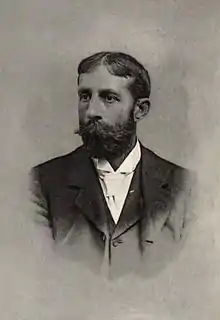Edwin Lord Weeks
Edwin Lord Weeks (1849 – 1903) was an American artist, noted for his Orientalist works.
Edwin Lord Weeks | |
|---|---|
 | |
| Born | 1849 Boston, Massachusetts |
| Died | November 1903 (aged 53-54) Paris, France |
| Nationality | American |
| Education | Léon Bonnat and Jean-Léon Gérôme, Paris |
| Known for | Painter, writer |
| Movement | Orientalist |
Life

Weeks was born in Boston, Massachusetts in 1849. His parents were affluent spice and tea merchants from Newton, a suburb of Boston, and as such they were able to finance their son's youthful interest in painting and travelling. As a young man Weeks visited the Florida Keys to draw, and also travelled to Surinam in South America. His earliest known paintings date from 1867 when he was eighteen years old, although it is not until his Landscape with Blue Heron, dated 1871 and painted in the Everglades, that Weeks started to exhibit a dexterity of technique and eye for composition—presumably having taken professional tuition.
In 1872 Weeks relocated to Paris, becoming a pupil of Léon Bonnat and Jean-Léon Gérôme.[1]
After his studies in Paris, Weeks emerged as one of America's major painters of Orientalist subjects. Throughout his adult life he was an inveterate traveler and journeyed to South America (1869), Egypt and Persia (1870), Morocco (frequently between 1872 and 1878), and India (1882–83).
In 1895 Weeks wrote and illustrated a book of travels, From the Black Sea through Persia and India,[2][3] and in 1897 he published Episodes of Mountaineering[4] (which was preceded by the 1894 article Some Episodes of Mountaineering, by a Casual Amateur).[5]
Weeks died in Paris in November 1903.[6] He was a member of the Légion d'honneur, France, an officer of the Order of Saint Michael (Bavaria), and a member of the Munich Secession.[4]
Achievements
Weeks exhibited his work in nearly every annual Salon (Paris). He earned a Medal of Honor in 1884, then a Third Class Medal in 1889, followed by a gold medal at the 1889 International Exhibition, and finally the Legion of Honor in 1896.[7]
Gallery
 A Maratha, leaving for hunting from Gwalior Fort
A Maratha, leaving for hunting from Gwalior Fort Maratha king of Gwalior at his palace
Maratha king of Gwalior at his palace A Maratha hunting party
A Maratha hunting party Promenade on a Maratha street
Promenade on a Maratha street Barge of the Maharaja Of Benares, 1883
Barge of the Maharaja Of Benares, 1883 On The River Benares, 1883
On The River Benares, 1883 Along the Ghats of Mathura, 1883
Along the Ghats of Mathura, 1883 The Maharajah at the Amer Fort, 1888
The Maharajah at the Amer Fort, 1888 A Mughal And His Court Returning From The Great Mosque At Delhi India
A Mughal And His Court Returning From The Great Mosque At Delhi India An Open-Air Restaurant near Wazir Khan Mosque, Lahore
An Open-Air Restaurant near Wazir Khan Mosque, Lahore Royal Elephant at the Gateway to the Jama Masjid, Mathura
Royal Elephant at the Gateway to the Jama Masjid, Mathura Entering the Mosque, 1885
Entering the Mosque, 1885 Interior of a Mosque at Cordova (circa 1880), The Walters Art Museum
Interior of a Mosque at Cordova (circa 1880), The Walters Art Museum The Taj Mahal, 1883, The Walters Art Museum
The Taj Mahal, 1883, The Walters Art Museum Arrival of a Caravan Outside the City of Morocco
Arrival of a Caravan Outside the City of Morocco
See also
References
- Telfair Museum of Art., & McCullough, H. K. (2005). Telfair Museum of Art: Collection highlights. Savannah, Ga: Telfair Museum of Art. p. 102. ISBN 0933075049.
- Weeks, Edwin Lord (1896). From the Black Sea through Persia and India. New York: Harper & Brothers.
- "Review of From the Black Sea through Persia and India by Edwin Lord Weeks". The Athenaeum (3558): 10–11. 4 January 1896.
- Chisholm, Hugh, ed. (1911). . Encyclopædia Britannica. 28 (11th ed.). Cambridge University Press. p. 466.
- Weeks, Edwin Lord (May 1894). "Some Episodes of Mountaineering, by a Casual Amateur". Scribner's Magazine. 15 (5): 531–553.
- American Art Annual, Volume 5. MacMillan Company. 1905. pp. 124.
- TIMES, Foreign Correspondence NEW YORK (19 April 1903). "THE TWO PARIS SALONS; American Artists Well Represented This Year. Some of the Principal Exhibits -- Edwin Lord Weeks Sends an Oriental Subject -- Many Works by Women" (PDF). The New York Times. Retrieved 14 October 2019.
Sources
- Edwin Lord Weeks, "Hindoo and Moslem", Harper's New Monthly Magazine, Vol. 91, No. 545, October 1895, pp. 651–669.
External links
| Wikimedia Commons has media related to Edwin Lord Weeks. |